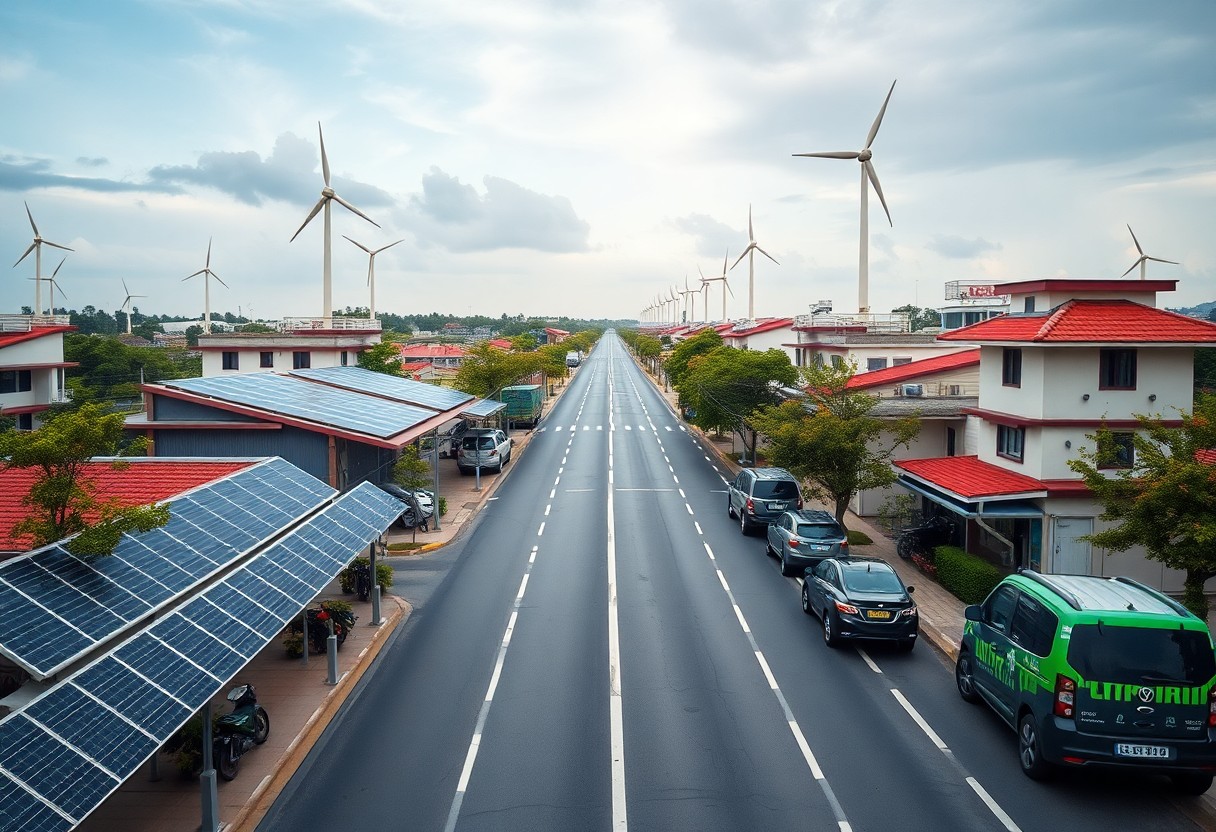Now Reading: Decentralized Physical Infrastructure Networks (DePINs) – Revolutionizing Shared Economies
-
01
Decentralized Physical Infrastructure Networks (DePINs) – Revolutionizing Shared Economies
Decentralized Physical Infrastructure Networks (DePINs) – Revolutionizing Shared Economies

With the rise of Decentralized Physical Infrastructure Networks (DePINs), you are witnessing a radical transformation in how shared economies operate. These networks empower individuals to leverage their assets and contribute to a more efficient, transparent, and sustainable economic model. By removing centralized control, DePINs enable you to engage in peer-to-peer transactions while optimizing resource allocation and minimizing waste. This innovative approach not only enhances economic opportunities for you but also fosters greater community collaboration and resilience.
Key Takeaways:
- DePINs leverage blockchain technology to create transparent and efficient systems for sharing resources, allowing individuals and organizations to collaborate without centralized control.
- By lowering barriers to entry and enabling decentralized ownership, DePINs empower communities to sustainably manage physical infrastructure, enhancing local economic growth.
- These networks encourage innovation by facilitating the integration of various assets and services, ultimately transforming traditional shared economy models into more scalable and resilient frameworks.
Understanding DePINs
For those eager to explore the potential of Decentralized Physical Infrastructure Networks – Blaize.tech, it’s vital to understand how they function. DePINs integrate digital technologies with physical assets, allowing communities to share resources more efficiently and transparently while reducing dependence on central authorities.
Definition and Core Principles
Above all, DePINs are innovative frameworks that utilize blockchain technologies to coordinate and manage shared physical infrastructure. Their core principles include decentralization, collaboration, and transparency, promoting a more sustainable and equitable approach to resource management.
How DePINs Differ from Traditional Infrastructure
The key distinction lies in the structure of governance and resource management. Instead of relying on centralized authorities, DePINs empower users to collectively control and operate shared assets.
Also, traditional infrastructure often requires significant investment and top-down control, leading to inefficiencies and inequities. In contrast, DePINs enable you to participate actively, eliminating middlemen and ensuring better transparency. This model fosters a stronger community engagement and encourages local initiatives, helping you to optimize resource use while reaping financial and environmental benefits. By shifting to this decentralized paradigm, you can contribute to a system that is more resilient and adaptive to local needs.
Key Technologies Powering DePINs
Now, let’s explore the key technologies that are driving the rise of Decentralized Physical Infrastructure Networks (DePINs). By leveraging advanced tools and frameworks, these systems enable more efficient, transparent, and equitable exchanges of resources among participants. Understanding these technologies not only helps you grasp their impact on shared economies but also prepares you to engage with the future of collective asset usage and management.
Blockchain and Smart Contracts
On the forefront of DePINs is blockchain technology combined with smart contracts, which provide the foundational layer for trustlessness and transparency. By utilizing a distributed ledger, all transactions are securely recorded and accessible to participants. Smart contracts automate agreements, allowing you to execute transactions without intermediaries, thus lowering costs and increasing efficiency.
Token Incentives and Governance
The role of token incentives and governance in DePINs is pivotal for maintaining engagement and fairness. Tokens can empower you as a participant, granting you voting rights and a stake in the network’s success. These incentive mechanisms encourage contributors to actively take part in decision-making and project sustainability, aligning individual goals with shared outcomes.
It’s crucial to understand how token incentives and governance mechanisms influence the dynamics of DePINs. These tokens not only reward your participation and contributions but also facilitate collective decision-making processes. By holding tokens, you can propose changes, vote on initiatives, and help allocate resources, ensuring that the network reflects your interests and priorities. This decentralized governance model reduces the risk of tyranny and encourages a fair representation of all members’ voices, fostering a community-driven environment that nurtures positive outcomes for everyone involved.
Applications of DePINs in Shared Economies
Once again, it’s clear that Decentralized Physical Infrastructure Networks (DePINs) are redefining the landscape of shared economies. By enabling the pooling of resources and offsetting the reliance on traditional centralized systems, DePINs create opportunities for individuals and communities to collaborate efficiently. Whether it’s energy, transportation, or communication, these applications pave the way for more sustainable and equitable economic models, offering you a chance to engage in innovative solutions that directly benefit you and your local community.
Decentralized Energy Grids
Above all, decentralized energy grids enable you to produce, consume, and trade energy locally, promoting energy independence and resilience. By harnessing solar panels and wind turbines within your community, these grids support renewable energy practices, reducing reliance on fossil fuels and driving lower costs for you as a consumer.
Distributed Wireless Networks
Beside energy solutions, distributed wireless networks empower you to access affordable and reliable internet connectivity. Through peer-to-peer sharing of bandwidth, these networks facilitate seamless communication and access to information, ultimately enhancing social and economic interactions within your community.
Consequently, as distributed wireless networks expand, they offer you the opportunity to connect with others and foster innovative community projects. By utilizing your existing resources, you can contribute to a shared bandwidth model that not only lowers costs but also enhances connectivity in underserved areas. This collaborative approach ensures resilience against disruptions while fostering a sense of community ownership, ultimately leading to a more inclusive digital economy for everyone involved.
Economic and Social Impacts of DePINs
Your engagement with Decentralized Physical Infrastructure Networks (DePINs) can lead to profound economic and social transformations. These networks foster sustainable shared economies by reducing reliance on traditional financial institutions, promoting local entrepreneurship, and enhancing community resilience. As indicated in What is DePIN? The Future of Decentralized Physical …, you can tap into a new realm of opportunities that uplift local communities while driving economic growth.
Reducing Costs and Barriers to Entry
By allowing you to access shared resources without hefty initial investments, DePINs significantly lower operational costs and barriers for individuals and small businesses. This newfound accessibility results in a more inclusive marketplace, where entry is less contingent on traditional funding sources.
Empowering Local Communities
At the heart of DePINs is the empowerment of local communities, granting you the ability to shape your economic landscape on your terms. By redistributing power and resources, these networks enable local stakeholders to actively participate in decision-making processes, fostering a sense of ownership and direct impact.
Understanding the dynamics of community engagement, DePINs enable residents to collaborate in a decentralized framework, effectively pooling resources and expertise to address local challenges. This model not only strengthens community bonds, but also leads to more efficient solutions and equitable access to services. As you participate in these networks, you can witness the positive ripple effects on job creation, social cohesion, and overall economic vitality in your community, shifting power dynamics away from centralized authorities.
Challenges and Considerations
Despite the immense potential of Decentralized Physical Infrastructure Networks (DePINs) to reshape shared economies, they face significant challenges that may impact their adoption. Issues like trust among participants, network performance, and interoperability must be resolved to ensure user satisfaction and system efficiency. As the technology continues to evolve, addressing these challenges will be paramount in realizing the full benefits of DePINs.
Scalability and Security Concerns
By implementing DePINs, you may encounter scalability and security issues that could hinder growth and threaten user safety. As the network expands, ensuring robust security measures and efficient protocols becomes increasingly important to protect sensitive data and maintain trust among users.
Regulatory and Legal Hurdles
Security regulations and legal frameworks often lag behind technological innovations, posing challenges for DePINs. Your organization must navigate a complex landscape to ensure compliance with *varied regulations* across jurisdictions, which can lead to *uncertainty* in operation and a lack of stability. This may further deter investment and participation in DePIN initiatives, slowing their adoption and reducing their transformative potential.
This legal maze can introduce significant obstacles to the growth of DePINs, as you’ll face issues such as *tax implications*, *liability concerns*, and *data protection laws*, which can vary widely from one region to another. Engaging with regulatory bodies is important for fostering a clearer understanding of the legal implications surrounding your participation in DePINs. Not addressing these hurdles may not only stifle innovation but also make it more challenging for you to engage investors, thereby impacting the long-term viability of your projects.
Future of DePINs
After exploring the transformative potential of Decentralized Physical Infrastructure Networks (DePINs), it becomes clear that they could redefine the landscape of shared economies. For more detailed insights, you can refer to What are Decentralized Physical Infrastructure Networks. As you research into DePINs, envision a future where equity, efficiency, and sustainability blend seamlessly, allowing communities to thrive through collective ownership.
Potential for Mass Adoption
After much discussion around the concept, the future of DePINs looks promising for mass adoption. With shifting societal norms valuing sustainability and shared resources, you will likely witness broader acceptance of these networks. You can also expect various industries to adapt and innovate, fueling a growing demand for decentralized infrastructures.
Integration with Emerging Technologies
Mass adoption of DePINs will intertwine with emerging technologies, accelerating their impact on society. Your interaction with advanced solutions such as artificial intelligence, IoT, and blockchain will make DePINs even more viable. These technologies enable seamless transactions and real-time data sharing, enhancing user experience.
Also, this integration offers a dynamic approach to resource management and service efficiency. If you consider how IoT devices can optimize infrastructure usage and blockchain technology can secure transactions, the landscape of DePINs becomes undeniably robust. However, you should be aware of potential cybersecurity risks that come with increased connectivity. Overall, the synergy between DePINs and emerging technologies presents an exciting frontier for innovative solutions and community engagement.
To wrap up
Ultimately, understanding Decentralized Physical Infrastructure Networks (DePINs) empowers you to navigate the evolving landscape of shared economies. By leveraging blockchain technology and community participation, DePINs offer innovative solutions that enhance efficiency and collaboration. As you consider the benefits of decentralized models, you position yourself to participate in a future where shared resources maximize value, reduce barriers, and transform how communities operate. Engaging with DePINs not only opens new opportunities for you but also contributes to a more sustainable and equitable economic framework.
Q: What are Decentralized Physical Infrastructure Networks (DePINs)?
A: Decentralized Physical Infrastructure Networks (DePINs) represent a novel approach to shared economies by leveraging blockchain technology and decentralized systems to manage and operate physical infrastructure. These networks facilitate resource sharing, enabling individuals and organizations to access and contribute to shared assets, such as transportation, energy sources, and other infrastructure components. By removing traditional intermediaries, DePINs enhance efficiency, reduce costs, and empower communities to collaboratively manage their resources.
Q: How do DePINs impact local economies and communities?
A: DePINs have the potential to significantly benefit local economies and communities by fostering collaboration and creating a more equitable distribution of resources. By allowing diverse participants to share infrastructure, these networks increase access to important services, reduce operating costs, and encourage local entrepreneurship. Furthermore, DePINs can stimulate job creation, promote sustainable practices, and enhance community resilience by orchestrating a collective approach for managing local assets, thus leading to improved economic stability and growth.
Q: What role does technology play in the functioning of DePINs?
A: Technology is integral to the functioning of DePINs, as it provides the framework for decentralized management and operation of physical infrastructure. Blockchain technology enables transparent and secure transactions, ensuring that contributions and usage of shared resources are recorded immutably. Smart contracts facilitate automated processes, such as access control and revenue distribution, without the need for intermediaries. Additionally, Internet of Things (IoT) devices can be utilized to monitor resource usage and performance in real-time, enhancing operational efficiency and trust among participants in the network.






















